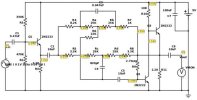
Tone control is a type of equalization used to make specific pitches or frequencies in an audio signal softer or louder. A tone control circuit is an electronic circuit that consists of a network of filters which modify the signal before it is fed to speakers, headphones or recording devices by way of an amplifier.
Tone control allows listeners to adjust sound to their liking. It also enables them to compensate for recording deficiencies, hearing impairments, room acoustics or shortcomings with playback equipment. For example, older people with hearing problems may want to increase the loudness of high pitch sounds they have difficulty hearing.
Tone control is also used to adjust an audio signal during recording. For instance, if the acoustics of the recording site cause it to absorb some frequencies more than others, tone control can be used to amplify or boost the frequencies the room dampens.
This classic tone control circuit uses a low noise transistor model which is interesting. The transistor makes the adjustment more suitable for the person to hear. The variable resistor also plays an important role in controlling the output. In the simulation it was transformed into a voltage divider theory having 50% resistance each. Notice the blue color waveform is the control output while the black is the input.
Eklentiler
Son düzenleyen: Moderatör:
